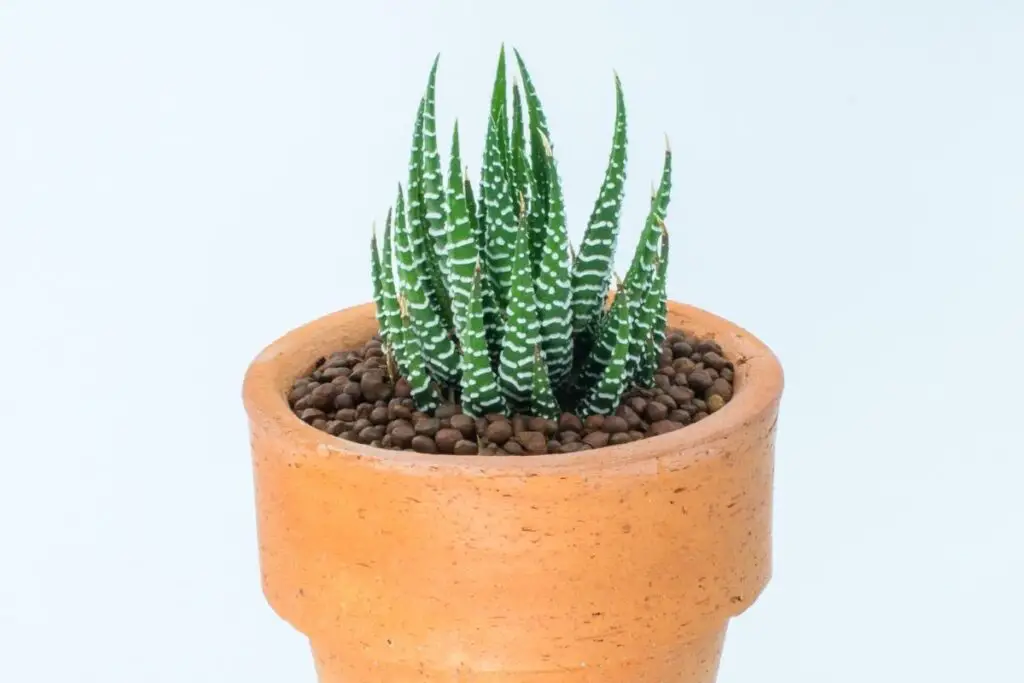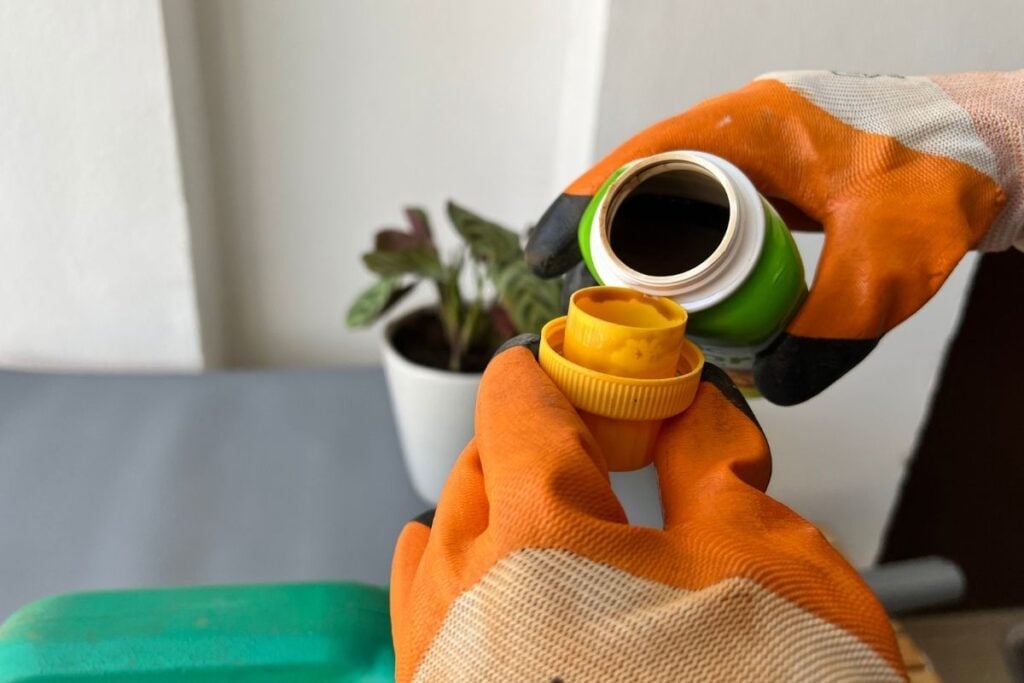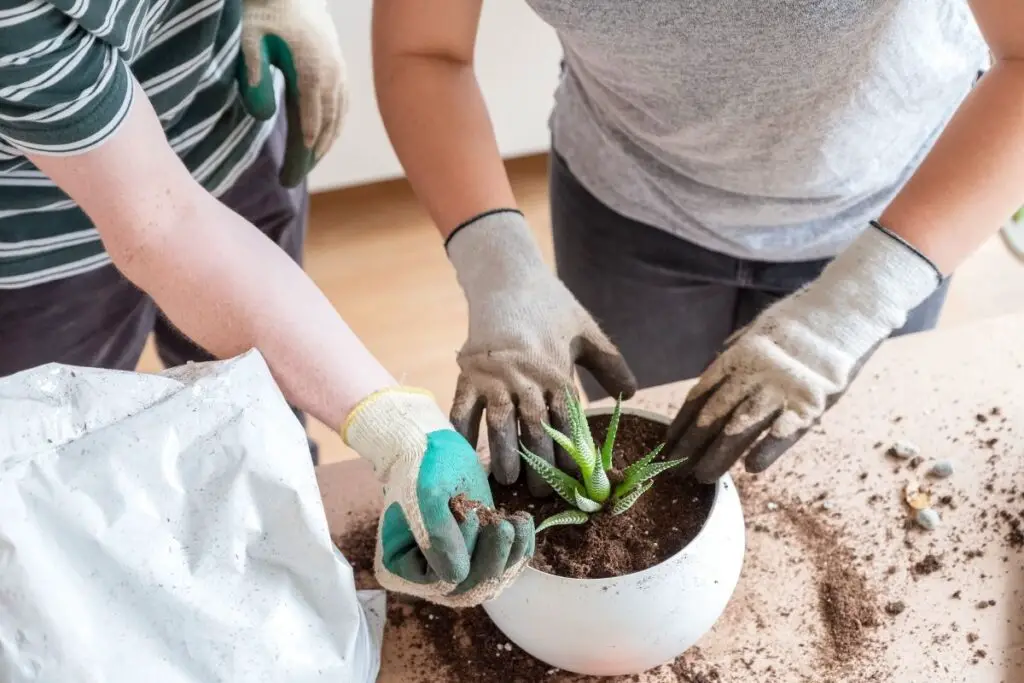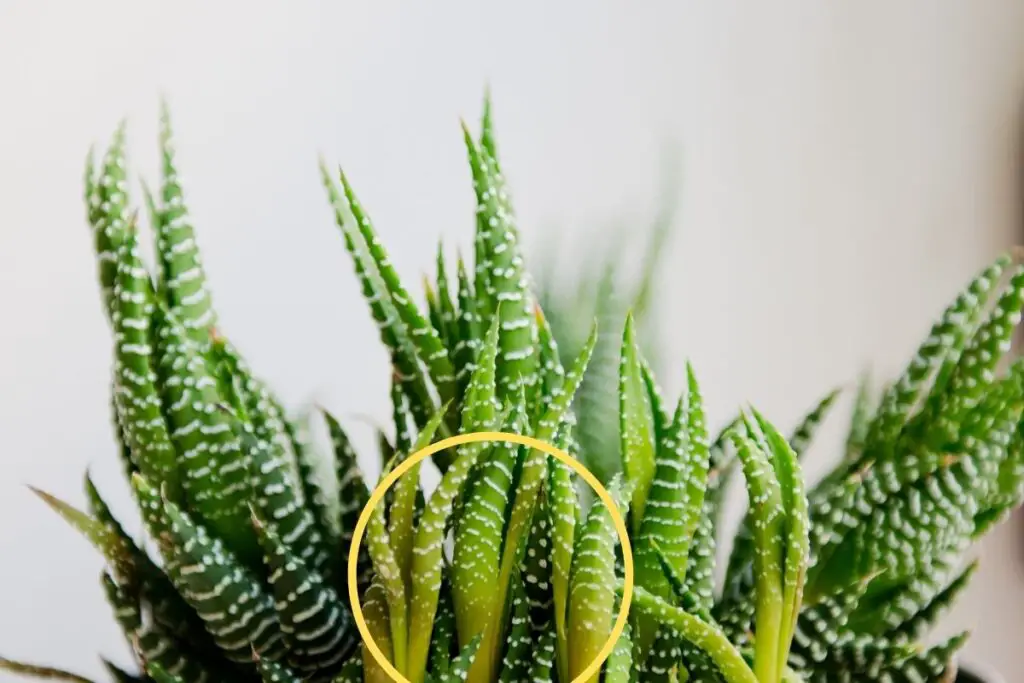Haworthias are small and slow-growing succulents. They do not need heavy fertilizing. Although, light feeding will not harm them. Instead, fertilization will help in their optimum growth.
But a common question that comes to everyone’s mind is how to fertilize haworthia and what is the best fertilizer to use?
Generally, it would be best to fertilize your haworthia once during the spring and once during fall because it is their growing season. You can use any fertilizer with an NPK ratio of 3:1:2 or 10:10:10 for ideal growth. Slow-fertilizers are also a good choice because it gets absorbed slowly.
Fertilizing Haworthias is a bit confusing for a beginner. But once you understand the right amount, frequency, time, and methods, it will become easy.
To learn to fertilize, this is the right place. I will share with you everything about fertilizing Haworthia.

Should I fertilize Haworthia?
Generally, Haworthias are slow-growing succulents, and they don’t need fertilization for fast growth.
However, you can fertilize them to boost their growth a little.
The soil used as a growing medium for Haworthia doesn’t contain many nutrients.
The focus is put more on drainage than nutrient-rich.
Moreover, some nutrients are needed by the plant for good growth.
These nutrients are absent in the plant tissues and must be offered.
That is why you should fertilize them.
They are light feeders, so you don’t need to fertilize them too frequently.
Otherwise, it will lead to fertilizer burn, thus triggering browning, rotting, and fungus development.
If you don’t fertilize them, despite their need for certain nutrients, it will result in red, yellow, or brown leaves.
Even the stems will turn solid brown or black.
What are the essential nutrients required for Haworthia?
As a general rule, all plants, including Haworthia, require three primary nutrients – Nitrogen (N), Phosphorus(P), and Potassium(K).
These encourage healthy growth, beautiful, patterned rich-colored foliage, and fighting diseases.
Other than these three nutrients, Haworthias will need many other micronutrients.
Everything should have a proper balance.
An unbalanced fertilizer will result in nutrient deficiency and make the plant toxic.
Below is the list of essential nutrients with their range and value needed by Haworthia:
- Nitrogen – ideal range: 100
- Phosphorus – ideal range: 13 to 19, optimal value: 16
- Potassium – ideal range: 45 to 80, optimal value: 62
- Magnesium – ideal range: 5 to 15, optimal value: 10
- Calcium – ideal range: 5 to 15, optimal value: 10
- Sulfur – ideal range: 6 to 9, optimal value: 8
- Iron – ideal range: 0.7
- Manganese – ideal range: 0.4
- Boron – ideal range:0.2
- Zinc – ideal range:0.06
- Chlorine – ideal range: 0.03
- Copper – ideal range: 0.03
- Molybdenum – ideal range: 0.003
- Silicon – ideal range: 86 (optional)
What is the best fertilizer for Haworthia?

For Haworthia, choose a fertilizer containing an NPK label in 3:1:2.
If you use a fertilizer lacking some nutrients, use other fertilizers to fulfill this shortage.
You can use a balanced fertilizer with NPK value 10-10-10 after making the dose half.
Synthetic fertilizers are also applicable for Haworthia.
They can mix very well in water.
Moreover, synthetic fertilizer gets absorbed by the plant very quickly.
It can encourage faster growth of the plant.
The best fertilizers for Haworthias are water-soluble fertilizers mixed with some growth hormones.
It will help in quick growth and strong rooting.
Slow-release fertilizers are also great for Haworthias.
It encourages in gradual absorption of nutrients.
It promotes the nutrients to get leached out when the excess water drains out of the soil.
Due to this, the salts don’t stay accumulated in the soil.
One suggestion would be the General Hydroponics 3 component mix.
It contains all the essential nutrients Haworthia needs.
You can also use silica fertilizers sometimes. It helps to fight pathogens.
But, before using it, check the pH level.
I will also suggest some other fertilizers later, so continue reading.
You can also use organic fertilizers like slurry or manure.
Add it to the soil bed and water thoroughly to spread it evenly.
How should I fertilizer my Haworthia?
Haworthia will need fertilizing only during their growing seasons.
To fertilize Haworthia correctly, follow the following steps:
- First, take a one-gallon container. Fill water later.
- Take 16 drops of hormone growth. It helps in good root growth.
- Take 1 gram of fertilizer you have bought for Haworthia.
- Now, add water to the container.
- Once you add water to the container, all the ingredients will automatically get mixed with water very well. There is no need to stir or shake it separately.
- After diluting the fertilizer with water, check the pH level once before applying.
- You don’t have to apply fertilizer separately. You can apply it instead of water when the right time arrives.
- Do this in their growing season 2-4 times with watering.
To use slow-release fertilizers:
- Sprinkle some slow-release fertilizer in the soil, 1 teaspoon per square foot.
- Water them thoroughly so that the nutrients get distributed evenly. Avoid leaf areas.
- Don’t over-fertilize. It will result in fertilizer burns.
- While using slow-release fertilizers, you don’t need to fertilize frequently. Since they are slow-release, the nutrients will gradually absorb the plant as per its need.
Looking for gardening supplies? We have tested 100's of products before recommending them to you guys. Check out our best pick below:
| Image | Gardening Supplies | Best Price? |
|---|---|---|
 Top
Top Top
Top | Raised Garden Bed Kit | Check On Amazon |
 | XLUX Soil Moisture Meter, Plant Water Monitor, Soil Hygrometer Sensor for Gardening, Farming, Indoor and Outdoor Plants, No Batteries Required | No Results |
 Top
Top Top
Top | 82 Pcs Garden Tools Set and Extra Succulent Tools Set | Check On Amazon |
 | Joeys Garden Expandable Garden Hose with 8 Function Hose Nozzle, Lightweight Anti-Kink Flexible Garden Hoses, Extra Strength Fabric with Double Latex Core, (50 FT, Black) | No Results |
 Top
Top Top
Top | Dual Chamber Compost Tumbler | Check On Amazon |
 Top
Top Top
Top | Sunnyglade Plant Stakes | Check On Amazon |
 Top
Top Top
Top | Organic Cold Pressed Neem Seed Oil | Check On Amazon |
 Top
Top Top
Top | Mighty Mint Gallon :-Insect and Pest Control Peppermint Oil | Check On Amazon |
 Top
Top Top
Top | Scotts DiseaseEx Lawn Fungicide | Check On Amazon |
 Top
Top Top
Top | Jacks Classic 20-20-20 All Purpose Fertilizer | Check On Amazon |
 Top
Top Top
Top | 30,000 Seeds Pollinator Attracting Wildflower Mixture | Check On Amazon |
 Top
Top Top
Top | Survival Vegetable Seeds Garden Kit-Over 16,000 Seeds | Check On Amazon |
Things to remember while fertilizing Haworthia
Specific facts need to be kept in mind while fertilizing Haworthia:
- Use low-balanced fertilizers, cacti fertilizers, or the recommended one. Haworthias are not heavy feeders.
- Always dilute the fertilizer with water and reduce the dose to half strength.
- If you are in doubt, don’t fertilize.
- Only change the soil to replenish the growing conditions from time to time. It will be enough to boost their growth.
- Fertilize during the growing seasons, which are spring and fall. Don’t fertilize during summer or winter.
- Fertilize only 2-3/4 times in one month.
- Before increasing the frequency, closely notice the plant’s reaction to your fertilization.
- Don’t combine 2-3 fertilizers to give them all their requirements. If any fertilizer lacks any nutrient, use another fertilizer separately to give them their missing nutrient.
When is the best time to fertilize Haworthia?

The best time to fertilize Haworthia is once during the spring and once in the fall.
These succulents grow actively during these seasons.
Since it is their growing months, they will absorb all the nutrients to function most favorably.
Do not fertilize them during the summers. They go through dormancy.
While resting, they won’t utilize these nutrients from the soil.
Fertilizing during this season may result in over-fertilization and trigger rotting.
Also, winter is not a good time to feed them.
Due to extreme temperatures, they slow down their growth process like summers.
Due to this, the plant won’t utilize the nutrients properly.
In conclusion, the best time to fertilize Haworthia is once in the spring and again in the fall.
How often should I fertilize Haworthia?
Haworthias are not heavy feeders.
So, you can worry less about fertilization frequency.
Generally, they need fertilizers one time every spring and fall.
You can fertilize them 2 to 4 times in one month during the spring and fall.
Don’t strictly follow this routine.
First, thoroughly check the plant’s reaction to fertilization.
If the plant experiences specific nutrient deficiencies, you can add them while watering.
You can do it every 3 to 4 months, except summer and winter.
But be careful.
Results of under-fertilization and over-fertilization

These will help you understand the importance of correct fertilization.
Under-fertilization
Haworthias don’t necessarily need fertilizing.
They can stay without fertilizers, provided they get all the nutrients adequately.
If you are repotting them or adding ingredients separately to rejuvenate the soil and improve its quality, Haworthia won’t mind if you don’t fertilize them.
But if these succulents are not getting the nutrients from the soil, you have to fertilize them.
It also boosts their growth and development.
The plant will show some symptoms if they are suffering nutrient deficiency:
- Foliage turning red or brown.
- The stems get solid brown or black.
Over-fertilization
If you are confused about fertilization frequency or amount, you can avoid fertilizing.
It won’t harm the plant unless you stop replacing the old soil with the new one.
You could easily save an under-fertilized plant, but over-fertilization causes serious issues.
If you use fertilizer in more quantity or frequently, it will result in over-fertilization.
The signs are:
- Browning at the tips, indicating fertilizer burn.
- The leaves will grow big and wild. They will have a grotesque appearance.
- It can lead to fungus development, especially if spilled too much and not washed off.
There is no harm if you don’t fertilize them.
They might grow slowly as that is their natural feature.
But it won’t harm too much.
The plant only experiences nutrient deficiency when you don’t change the soil.
If you replace the soil, they will stay fit and not show any nutrient deficiency signs.
Best fertilizers for Haworthia
Let’s share some suitable fertilizers for Haworthia.
Most importantly, you can use them for both outdoor and indoor Haworthias.

Cute Farms Succulent, Cacti, and Aloe fertilizer
Cute Farms Succulent, Cacti, & Aloe Fertilizer is available in a squeeze bottle for continuous use and application for small succulents.
The formula of this fertilizer is liquid-gel-based.
They are easy to apply on the Haworthias.
Since Haworthias are small succulents, it will work great for them.
Along with Haworthia, you can also use them on other small succulents like cactus or aloe vera.
The problems with this fertilizer are that it is expensive and needs to be applied every month.
Unlike slow-release fertilizers, this fertilizer leaches in soil very quickly.
Osmocote Smart-release Plant Food
Liquid fertilizers get leached out from the soil with every watering.
But slow-release fertilizers don’t leach out so quickly.
That is why, when applied, you can sit back for 5-6 months without fertilizing.
The salts, too, don’t stay in the soil. It slowly leaches out with watering.
Osmocote Smart-release Plant Food is an excellent slow-release fertilizer and contains nutrients that Haworthia needs.
This fertilizer has 11 nutrients that can give your Haworthia a complete balance of nutrients.
The only problem is it can burn the roots due to its formula.
You need to consult an expert and use it correctly if you don’t want your plant to burn.
Fat Plants San Diego Premium
Applying fertilizer separately can be very hectic and time-consuming.
What if you get soil that already holds all the essential nutrients? This product is of that kind.
Fat Plants San Diego Premium is a mixture of fertilizer and soil which refreshes the soil.
You don’t need to take out time separately to fertilize them.
Use it whenever you repot your Haworthia.
It is a great product, easy to use, and long-lasting.
It contains the essential nutrients needed by Haworthia.
The only problem is you can’t control the fertilizer amount of the soil mixture.
Miracle-Gro Succulent Plant Food
Miracle-Gro Succulent Plant Food is also available in a squeeze bottle.
It is perfect for small indoor succulents.
It contains a very light formula, preferable for monthly use.
Besides Haworthia, you can use this fertilizer for other succulents like aloe vera or cactus.
Apart from these fertilizers, you can also use Triple 10 All Purpose Liquid Fertilizer or FDF plant food with an NPK ratio of 3-1-2.
Final words
Haworthias don’t need much fertilizing. But it won’t harm them if you give them some. Instead, it can boost their growth.
Fertilize them once during the spring and fall. Use water-soluble fertilizers for best results as it gets absorbed quickly. But the problem is you have to reapply.
Slow-release fertilizers are also best because they are absorbed gradually as per the plant’s need. It gets leached with every watering and doesn’t need frequent re-application.
Whichever fertilizer you use, be cautious not to over-fertilize it. Under-fertilization doesn’t cause much harm as over-fertilization would do.
Moreover, it can be challenging to treat the latter. If you are unsure about the amount or frequency, avoid it. Just restore the soil every 2-3 years to boost their growth.
Reference: The Haworthia Society, Botanical Studies, University of Wisconsin-Madison, Sciencedirect, Researchgate, Haworthia Study.
